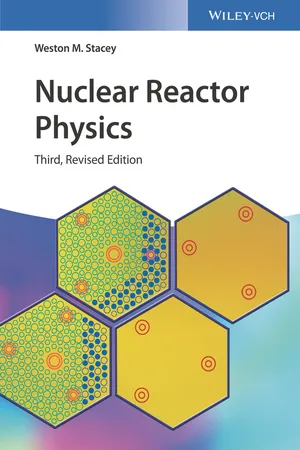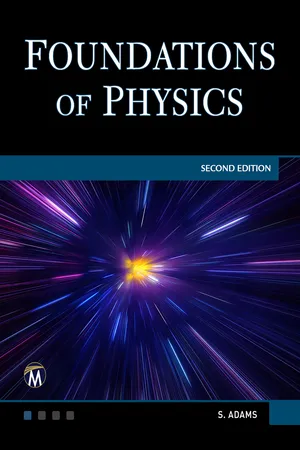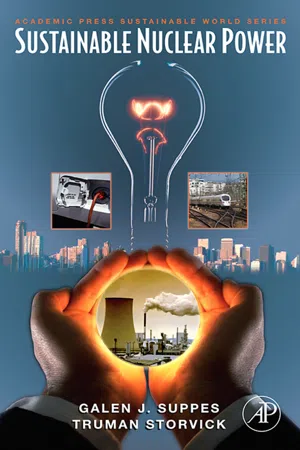Physics
Disintegration Energy
Disintegration energy refers to the energy released when a nucleus undergoes radioactive decay. It is the difference in mass-energy before and after the decay process. This energy is often released in the form of gamma rays, alpha particles, or beta particles, and is a fundamental concept in understanding the behavior of radioactive materials.
Written by Perlego with AI-assistance
Related key terms
Related key terms
1 of 4
Related key terms
1 of 3
4 Key excerpts on "Disintegration Energy"
- eBook - ePub
- Weston M. Stacey(Author)
- 2018(Publication Date)
- Wiley-VCH(Publisher)
1 Neutron–Nuclear ReactionsThe physics of nuclear reactors is determined by the transport of neutrons and their interaction with matter within a reactor. The basic neutron nucleus reactions of importance in nuclear reactors and the nuclear data used in reactor physics calculations are described in this chapter.1.1 Neutron-Induced Nuclear Fission
Stable Nuclides
Short-range attractive nuclear forces acting among nucleons (neutrons and protons) are stronger than the Coulomb repulsive forces acting among protons at distances on the order of the nuclear radius (R ≈ 1.25 × 10−13 A1/3cm) in a stable nucleus. These forces are such that the ratio of the atomic mass A (the number of neutrons plus protons) to the atomic number Z (the number of protons) increases with Z; in other words, the stable nuclides become increasingly neutron-rich with increasing Z, as illustrated in Fig. 1.1 . The various nuclear species are referred to as nuclides, and nuclides with the same atomic number are referred to as isotopes of the element corresponding to Z. We use the notation (e.g., ) to identify nuclides.Nuclear stability curve. (With permission from Ref. [1]. Copyright 1996, McGraw-Hill.)Fig. 1.1Binding Energy
The actual mass of an atomic nucleus is not the sum of the masses (mp) of the Z protons and the masses (mn) of A − Z neutrons of which it is composed. The stable nuclides have a mass defect:(1.1)This mass defect is conceptually thought of as having been converted to energy (E = Δc2 ) at the time that the nucleus was formed, putting the nucleus into a negative energy state. The amount of externally supplied energy that would have to be converted to mass in disassembling a nucleus into its separate nucleons is known as the binding energy of the nucleus, BE = Δc2 . The binding energy per nucleon (BE/A) is shown in Fig. 1.2 .Fig. 1.2 - eBook - ePub
- Steve Adams(Author)
- 2023(Publication Date)
- Mercury Learning and Information(Publisher)
26NUCLEAR PHYSICS26.1 NUCLEAR ENERGY CHANGESNucleons inside nuclei are in bound states. This means that their total energy is negative and work would have to be done to separate them. The work that must be done is called the binding energy of the nucleus. Note that this is not energy in the nucleus, it is energy that must be supplied to break it apart or that would be released if the nucleus formed from separate nucleons. When nuclear transformations such as radioactive decay, nuclear fission, or nuclear fusion occurs, the total binding energy of the system changes and energy can be released, for example, in the form of the kinetic energy of the products of the reaction. Einstein’s mass-energy relationship, E = mc 2 , links these energy changes to mass changes.26.1.1 Nuclear Binding EnergyThe binding energy of a nucleus is equal to the work that must be done to separate all of the nucleons in the nucleus so that they are no longer interacting. In theory, this would mean separating them to infinite distances but the strong nuclear force that binds them together is extremely short range and effectively falls to zero at distances greater than a few times 10−15 m:The energy of a nucleon is lower when it is inside the nucleus than when it is a free particle so its mass is also lower. The total mass of a nucleus is therefore less than the sum of the rest masses of the free nucleons from which it is made. The difference in mass between the mass of the free nucleons and the mass of the nucleus is called the mass defect ∆m for the nucleus. The binding energy B.E. of the nucleus is equal to the mass defect multiplied by the speed of light squared.Mass defect = (sum of masses of free nucleons) − (mass of nucleus)Binding energy: B.E. = c 2 ∆mBinding energy per nucleon: B.E./A = c 2 ∆m /AWhen carrying out calculations of nuclear binding energy it is important to use nuclear mass and not atomic mass. Most tables of data give atomic masses so the mass of Z electrons must be subtracted from this. The data below has been used to calculate the binding energy and binding energy per nucleon of an oxygen-16 nucleus. - eBook - ePub
Renewable Energy
A First Course
- Robert Ehrlich, Harold A. Geller, John R. Cressman(Authors)
- 2022(Publication Date)
- CRC Press(Publisher)
2 because of differences between the binding energies of the initial and final states.4 Were it possible to somehow convert 1 kg of stuff entirely into energy, the amount available would be 9 × 1016 J or enough to supply all of New York City’s electricity for nearly 2 years.3.10 Nuclear Binding Energy
The strong force holds the nucleus together against the much weaker Coulomb repulsion (between protons), so it should not be surprising that it would require a massive amount of energy to disassemble a nucleus into its constituent nucleons. The energy of total disassembly represents the binding energy of the nucleus, which simply equals the difference in mass between all the constituents (Z protons and N neutrons) and the original nucleus times c2 , or as in the following equation:E B=(Z)m P+ Nm n− Mc 2.(3.11 )Consider a plot of EB /A (binding energy per nucleon), shown in Figure 3.6 .Figure 3.6Curve of nuclear binding energy per nucleon, or EB /A versus number of nucleons A. (Courtesy of Mononomic, http://en.wikipedia.org/wiki/File:Binding_energy_curve_-_common_isotopes_with_gridlines.svg.)Nuclei having the largest values of EB /A tend to be the most stable, and hence, they are the most tightly bound. These nuclei also have the smallest nuclear mass in relation to that of the constituents by virtue of Equation 3.11 . According to Figure 3.6 , the most stable nucleus is iron (Fe56 ). Many students are confused by the sign of the binding energy. Obviously, it must be positive based on its definition as the work needed to disassemble a bound system (the nucleus). However, the potential energy responsible for binding the system together is negative earlier—see Figure 3.7 - eBook - ePub
- Galen J. Suppes, Truman Storvick(Authors)
- 2006(Publication Date)
- Academic Press(Publisher)
Binding energy is defined as the amount of energy that must be supplied to a nucleus to completely separate its nuclear particles (nucleons). It can also be understood as the amount of energy that would be released if the nucleus was formed from the separate particles. Binding energy is the energy equivalent of the mass defect. Since the mass defect was converted to binding energy (BE) when the nucleus was formed, it is possible to calculate the binding energy using a conversion factor derived by the mass-energy relationship from Einstein’s Theory of Relativity. Energy Levels of Atoms The electrons that circle the nucleus move in well-defined orbits. Some of these electrons are more tightly bound in the atom than others. For example, only 7.38 eV is required to remove the outermost electron from a lead atom, while 88,000 eV is required to remove the innermost electron. The process of removing an electron from an atom is called ionization, and the energy required to remove the electron is called the ionization energy. In a neutral atom (number of electrons = Z), it is possible for the electrons to be in a variety of different orbits, each with a different energy level. The state of lowest energy is the one in which the atom is normally found and is called the ground state. When the atom possesses more energy than its ground state energy, it is said to be in an excited state. An atom cannot stay in the excited state for an indefinite period of time. An excited atom will eventually transition to either a lower-energy excited state, or directly to its ground state, by emitting a discrete bundle of electromagnetic energy called an x-ray. The energy of the x-ray will be equal to the difference between the energy levels of the atom and will typically range from several eV to 100,000 eV in magnitude. Energy Levels of the Nucleus The nucleons in the nucleus of an atom, like the electrons that circle the nucleus, exist in shells that correspond to energy states
Index pages curate the most relevant extracts from our library of academic textbooks. They’ve been created using an in-house natural language model (NLM), each adding context and meaning to key research topics.
Explore more topic indexes
Explore more topic indexes
1 of 6
Explore more topic indexes
1 of 4



